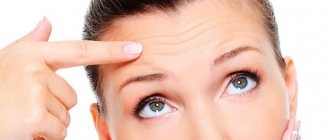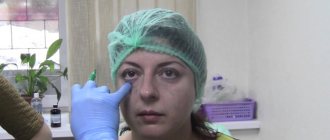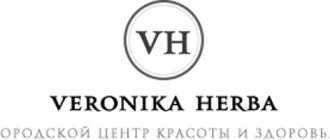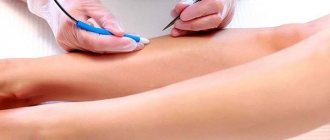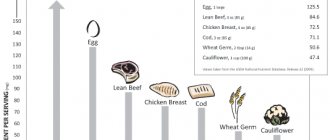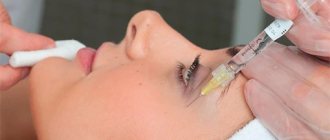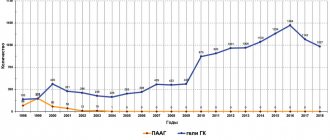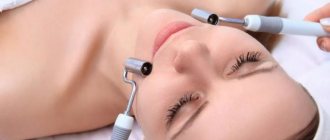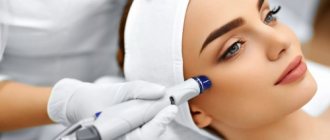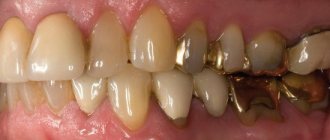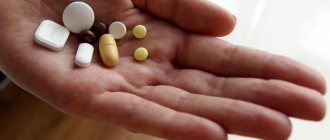Purpose of a chemical peel
The key goal of chemical peeling is to neutralize various cosmetic defects - mesh and expression wrinkles, age spots, acne scars, enlarged pores, comedones and other signs of aging or “problematic” skin.
Damage to the epidermis is achieved by applying a special composition with a certain concentration of organic acids to the surface of the skin. Against the background of a kind of stress, skin cells begin to regenerate and proliferate. In the middle and deep layers, the process of elastin and collagenogenesis starts - the production of young, strong and intact fibers of the “proteins of youth” - elastin and collagen. As a result, the skin becomes denser, elastic and hydrated.
How is it different from others
Compared to other types of peelings, with chemical peels the procedure for renewing the surface layers of the skin is carried out through the use of acids. When a composition with acids is applied to the skin, it is damaged, followed by healing and renewal.
Such methods were used several centuries ago. In Egypt, sour cream (rich in lactic acid) was used for this purpose; in France, old wines (containing tartaric acid); in Greece and Rome, lemon juice was used.
Despite the fact that the task of chemical peeling is the same as that of other types - to cleanse the skin, it is less traumatic.
Indications for chemical peeling
- Fine wrinkled type of aging;
- Superficial or medium-deep skin breaks;
- Enlarged pores;
- Open or closed comedones (“blackheads”, inflamed sebaceous plugs);
- Hyperpigmentation;
- Hyperkeratosis (insufficient desquamation of the horny cells of the epidermis, making the skin rough and preventing its normal breathing);
- “Stressed” skin (dull grayish or sallow complexion; irritation, thinning, tightness);
- Skin pattern defects;
- Increased sebum secretion;
- Ichthyosis (cracking and scaly skin);
- Acne;
- Post-acne (atrophic / hypertrophic scars, dark stagnant spots);
- Scarring of the skin;
- Striae (stretch marks).
Superficial chemical peeling
Superficial chemical peeling is the most delicate and gentle of the three presented. It is used for light rejuvenation of the skin of the face, neck and décolleté. Superficial chemical peels are carried out using weak (10-20%) solutions of the following acids:
- Apple;
- Lemon;
- Pyruvic;
- Dairy;
- Azelaic;
- Salicylic;
- Glycolic.
Superficial chemical peeling is classified as a weekend procedure. With proper preparation and post-peeling care, the face acquires a socially acceptable appearance already on the third day. After peeling on Friday, by Monday you will be able to return to work without any traces of damage on your face (redness, swelling, thick crust, etc.).
The choice in favor of a specific acid is made by a cosmetologist based on the results of preliminary diagnostics.
Glycolic acid is one of the most popular agents for superficial chemical peels. It has optimal penetrating ability and hydration properties. Glycolic peeling is indicated not only for cleansing, but also for moisturizing the skin. The second effect is achieved through the binding of water molecules in the intercellular space.
Salicylic acid is used primarily to treat typically “problem” skin prone to clogged pores, acne and oily skin. Salicylic peeling is often prescribed in complex acne therapy.
Azelaic (nonandioic) acid has keratolytic and antibacterial properties, which allows it to be used in the treatment of acne along with salicylic acid.
Lactic acid has the most gentle effect on the skin, so milk peeling, unlike the vast majority of others, is acceptable even in the sunny season (the risks of post-peeling hyperpigmentation are minimized). The main function of milk peeling is to restore the natural hydrolipidic balance of the skin.
Pyruvic acid is preferred for patients with thin and sensitive skin. It protects it from fluid loss, compacts it and increases contractility.
Citric acid is designed to fight age spots and brighten skin tone. Lemon peeling is ideal for combating photoaging.
Malic acid has astringent and drying properties, so apple peeling is suitable for professional care for oily skin.
Retinoic (“yellow”) also conventionally belongs to superficial peelings, but in its effect it is comparable to the middle one. The acid composition includes retinoic acid and auxiliary acids - ascorbic, phytic, azelaic, kojic. The components have a comprehensive effect on the skin - they increase its turgor and elasticity, smooth out its texture, thicken and strengthen it.
With superficial peeling, only the upper layer of the epidermis is involved - acids penetrate to a depth of about 0.05-0.06 mm.
Medium chemical peel
Medium chemical peeling covers the deeper structures of the skin - the entire stratum corneum to the spinous layer of the dermis and the surface of the basement membrane. The penetration depth of the solution is approximately 0.40-0.45 mm. This version of the procedure is more painful and traumatic than the previous one, but at the same time it is more effective, especially in the fight against age-related changes.
Medium peels are traditionally carried out using trichloroacetic (30-40%) and salicylic (30%) acid, as well as combined solutions. Trichloroacetic acid has a relatively gentle effect on the skin, without damaging immunocompetent cells, so the skin is restored faster. Despite the safety of the substance, medium peeling can only be done in a clinic or the office of a professional cosmetologist, but under no circumstances at home!
The procedure allows you to eliminate problems such as linear and expression wrinkles, dark and large pigment spots, cicatricial changes in the skin, including stretch marks.
Medium peeling is followed by full rehabilitation of 7-10 days. During this period, redness and irritation of the skin persist, and closer to 4-5 days a rather dense crust begins to come off. When using salicylic acid, abundant, deep and intense peeling is observed with characteristic itching and discomfort.
After the procedure, the patient is required to take especially careful and competent skin care. It urgently needs deep hydration and nutrition, as well as protection from ultraviolet radiation. During rehabilitation, it is better not to be exposed to direct sunlight, and then it is important to use creams and serums with a high SPF (minimum 30). Medium peeling is carried out only in cloudy and cool seasons. The optimal season is late autumn or early spring.
Deep chemical peeling
Deep chemical peeling is a rare procedure in modern practice. Many alternatives have been found to it, so cosmetologists resort to it rather in exceptional cases. It is an extensive burn of the epidermis, leading to exposure of the papillary dermis. It is performed in a hospital under general anesthesia. It is characterized by high risks, therefore it requires special skill, experience and skills from the cosmetologist.
The procedure is carried out using a phenol solution. Phenol significantly injures the skin - its effect is equivalent to a third-degree burn. Rehabilitation after phenol peeling lasts about 6 months. The effect lasts up to 3-5 years.
Deep chemical peeling is used to smooth out very sharp, loose and old wrinkles, furrows and folds, as well as rough hypertrophic (non-keloid) scars.
Algorithm for chemical peeling
Before any type of chemical peel, preparation is necessary. The cosmetologist will pre-consult you on the care that you will need to use for 1-2 weeks before the procedure. As a rule, it involves washing and toning the face with products with a low concentration of acids.
The peeling itself (superficial and medium) is carried out according to the following protocol:
- Makeup removal and skin cleansing;
- Determination of exposure time to acid solution;
- Applying the solution to prepared skin;
- Application of subsequent layers (if provided);
- Removing acid solution from skin;
- Treatment of the skin with softening and soothing agents with a sun protection factor;
- Consultation on post-peeling care.
Post-peeling care is prescribed to fix and prolong the results of peeling, as well as to protect against complications. The care option is selected by the cosmetologist, and the patient only needs to follow his recommendations. Tell the cosmetologist in advance about your financial capabilities so that the care matches them, and you do not have to skimp on the quality of cosmetics. Please note that visiting saunas, steam baths, swimming pools and solariums will be prohibited for 3-5 weeks after peeling.
Contraindications to chemical peeling
- Tumor processes;
- Severe somatic pathologies (organic and systemic);
- Chronic dermatological diseases in the acute stage;
- Viral, bacterial and parasitic skin lesions;
- Telangiectasia;
- Keloidosis;
- Slow wound regeneration;
- Dark skin or skin with a fresh tan;
- Schematic use of systemic or topical retinoids/photosensitizing drugs;
- Aggressive procedures or plastic surgery completed less than 2 months ago.
Milk peeling: for dry skin
Natalia Solomennikova Fashion editor, 24 years old
Skin type : dry
Problem : peeling, dull complexion, rare rashes
Desired result : even complexion and elimination of flaking
Cosmetologist's solution : milk peeling.
Description : milk peeling is one of the most gentle and painless, while it is considered one of the most effective. After application, lactic acid penetrates the skin and gently destroys dead cells, which are delicately exfoliated within a week after the procedure. In addition to being able to remove dead cells, peeling stimulates collagen production. This is a kind of shock for the skin, after which it begins to renew itself, becoming smooth and youthful.
Review : “The only drawback of the procedure is the pungent odor and slight burning sensation during the peeling period. I was warned about the chemical smell, but I attributed the second one to high skin sensitivity. But I knew that I was in good hands and simply trusted my cosmetologist. And for good reason. I noticed the desired effect on the third day after the procedure. On the first day, the skin tightened slightly, but there were no external changes yet. On the second day, a slight flaking appeared in the morning, which I treated with moisturizer. The next day, the dryness and discomfort disappeared. And the skin became perfectly smooth, acquired a beautiful color and even a slight blush. Will I exfoliate again? Without a doubt. Now this is my must have before an important event where you need to look your best.”
Rating : 10 out of 10.
How often can you do it
The permissible frequency of chemical peeling sessions directly depends on its type: superficial, weakly concentrated formulations can be used at least daily, but deep peeling is done only once in a lifetime.
Medium peeling is usually done in a course of 4-6 procedures, with the interval between sessions exceeding a week. When using highly concentrated drugs, the procedure is performed once and is repeated no more than once a month.
The frequency of chemical peeling also depends on age: up to 30 years, one session is usually enough to solve existing skin problems and activate skin renewal processes; after 30 years, experts recommend a course of therapy.
Acids used and popular products
Chemical peeling preparations contain various acids. In compositions for superficial procedures they are included in a weakly concentrated form - up to 20%, for medium renewal - from 20% to 70%.
Chemical peels typically combine the following acids:
- retinol;
- pyruvic;
- trichloroacetic;
- azelaic;
- almond;
- glycolic;
- salicylic;
- dairy;
- Phytic
The most popular peels are those based on fruit acids (AHA) - they combine safety, affordability and high efficiency.
Different drugs are created to combat different problems. Manufacturers carefully select the components for their formulations, combining substances according to the required purpose in different concentrations. Thus, salicylic acid has a pronounced anti-inflammatory effect and is included in preparations for anti-acne procedures, and azelaic acid is included in anti-pigment agents. Lactic acid helps moisturize the skin, while retinol and glycolic acids effectively accelerate cell regeneration.
Professional medium peeling is most often performed with Jessner's solution; this drug includes TCA (trichloroacetic acid) and glycolic acid in a concentration of 50-70%.
Facilities
Cosmetology offers a wide selection of chemical peeling products; each professional has his own preferences in choosing lines of preparatory, working and care products produced by the following brands:
- Skin Tech;
- GiGi;
- Mediderma;
- Algologie;
- Kosmoteros;
- Holy Land;
- Arcadia;
- Dermalogica.
In addition to professional products that can only be used in salons, there are also light superficial peels produced by well-known cosmetic companies. Such drugs can be used for home procedures.
Almond peeling for normal skin
Daria Serova Content director, 29 years old
Skin type : normal, combination
Problem : oily T-zone, spot inflammation, mild expression lines
Desired result : elimination of oily shine, post-acne and fine wrinkles
Cosmetologist's solution : almond peeling
Description : mandelic acid acts very gently and is suitable for sensitive and thin skin. It gently exfoliates the skin and does not cause discomfort. The advantages of almond peeling include the fact that it is suitable for various skin phototypes, and can also be used despite solar activity, although for most peels this is one of the main contraindications. First of all, almond peeling rejuvenates, cleanses and heals the skin.
Feedback : “I am very pleased with the result. Although I didn’t decide to have the procedure right away. It is generally accepted that peeling requires at least a week of rehabilitation and no sun. And I was planning a trip to Bali very soon. During the consultation, I was told about all-season peels that can be done even before a beach holiday. The main thing is to protect your skin with cream with SPF 50 at first. Did I get the desired result? Rather yes than no. The skin became matte and smooth. True, facial wrinkles remained with me. But I think we need to learn to love them - these are traces of a smile and happy emotions.”
Rating : 7 out of 10.

